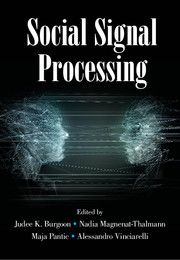Book contents
- Frontmatter
- Contents
- Contributors
- 1 Introduction: Social Signal Processing
- Part I Conceptual Models of Social Signals
- Part II Machine Analysis of Social Signals
- 11 Facial Actions as Social Signals
- 12 Automatic Analysis of Bodily Social Signals
- 13 Computational Approaches for Personality Prediction
- 14 Automatic Analysis of Aesthetics: Human Beauty, Attractiveness, and Likability
- 15 Interpersonal Synchrony: From Social Perception to Social Interaction
- 16 Automatic Analysis of Social Emotions
- 17 Social Signal Processing for Automatic Role Recognition
- 18 Machine Learning Methods for Social Signal Processing
- Part III Machine Synthesis of Social Signals
- Part IV Applications of Social Signal Processing
- References
13 - Computational Approaches for Personality Prediction
from Part II - Machine Analysis of Social Signals
Published online by Cambridge University Press: 13 July 2017
- Frontmatter
- Contents
- Contributors
- 1 Introduction: Social Signal Processing
- Part I Conceptual Models of Social Signals
- Part II Machine Analysis of Social Signals
- 11 Facial Actions as Social Signals
- 12 Automatic Analysis of Bodily Social Signals
- 13 Computational Approaches for Personality Prediction
- 14 Automatic Analysis of Aesthetics: Human Beauty, Attractiveness, and Likability
- 15 Interpersonal Synchrony: From Social Perception to Social Interaction
- 16 Automatic Analysis of Social Emotions
- 17 Social Signal Processing for Automatic Role Recognition
- 18 Machine Learning Methods for Social Signal Processing
- Part III Machine Synthesis of Social Signals
- Part IV Applications of Social Signal Processing
- References
Summary
Introduction
In everyday life, people usually describe others as being more or less talkative or sociable, more or less angry or vulnerable to stress, more or less planful or behaviorally controlled. Moreover, people exploit these descriptors in their everyday life to explain and/or predict others’ behavior, attaching them to well-known as well as to new acquaintances. In all generality, the attribution of stable personality characteristics to others and their usage to predict and explain their behavior is a fundamental characteristics of human naive psychology (Andrews, 2008).
As agents that in increasingly many and varied ways participate in and affect the lives of humans, computers need to explain and predict their human parties’ behavior by, for example, deploying some kind of naive folk-psychology in which the understanding of people's personality can reasonably be expected to play a role. In this chapter, we address some of the issues that attempts at endowing machines with the capability of predicting people's personality traits.
Scientific psychology has developed a view of personality as a higher-level abstraction encompassing traits, sets of stable dispositions toward action, belief, and attitude formation. Personality traits differ across individuals, are relatively stable over time, and influence behavior. Between-individual differences in behavior, belief, and attitude can therefore be captured in terms of the dispositions/personality traits that are specific to each individual, in this way providing a powerful descriptive and predictive tool that has been widely exploited by, for example, clinical and social psychology, educational psychology, and organizational studies.
The search for personality traits has been often pursued by means of factor-analytic studies applied to lists of trait adjectives, an approach based on the lexical hypothesis (Allport & Odbert, 1936), which maintains that the most relevant individual differences are encoded into the language, and the more important the difference, the more likely it is to be expressed as a single word.
- Type
- Chapter
- Information
- Social Signal Processing , pp. 168 - 182Publisher: Cambridge University PressPrint publication year: 2017
References
- 1
- Cited by



